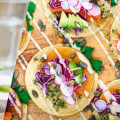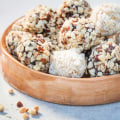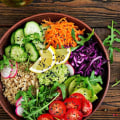Breakfast consisted of instant natural oatmeal, fruit salad (from the breakfast bar) and some Ezekiel cereal, tea and soy milk. The lunch consisted of canned soup (organic minestrone from Health Valley), toasted bread (Ezequiel bread) and salad (vegetables, chopped carrots, cucumber and yellow peppers, balsamic vinegar, black beans and red beans and salsa). The dinner consisted of mixed rice (brown, red, black), chopped sweet potato (in the microwave), beans, arugula and sauce. The desert was plums and some pistachios.
Some of my favorite options are a banana with peanut butter, a couple of dates, a piece of toast or an apple with peanut butter. That particular morning, I ate a fresh gala apple with some crunchy peanut butter. Apples are in fall season, and mine didn't disappoint me. How to help you lead a healthy vegan lifestyle Whether you're newly vegan or have been eating plant-based products for a while, you've probably wondered how much of everything you should eat to get all the nutrients you need.
The best way to ensure that you are consuming all the nutrients as a vegan is to follow the vegan dish method. This method shows all of the critical foods and the amount of each one you should eat every day. Many countries around the world use the Plate of Food Method to show and encourage their citizens to obtain adequate nutrition with the basic foods available in that country. As you can imagine, there are a lot of variations of dishes in the world.
Since I am based in the U.S. UU. ,. Guidelines on dishes that have been modified for plant-based consumers.
It's a good guide to use and, having lived abroad, I think all of the foods I mention below are widely accessible and affordable. A healthy plant-based diet should include 5 servings of vegetables a day. Is it a lot or a little? What is a serving size? Is it possible to eat so much in one day? Now that we know what the serving size is, let's break it down to see how it translates to daily meals. You should try to mix raw and cooked vegetables during the day.
If you want to skip a salad for lunch or dinner, drink ½ cup of freshly squeezed vegetable juice for breakfast or as a mid-morning snack. Juicing is the easiest way to increase your daily vegetable intake. You can easily drink 1 cup of fresh vegetable juice in one sitting. Alternatively, you can have a green smoothie for breakfast with 1 cup of spinach or kale.
If you don't feel like cooking for dinner, increase the leafy greens to 2 cups and add more fresh vegetables to create a big, delicious salad. Nor do you shy away from eating vegetables for breakfast. Avocado toast, tofu or scrambled chickpea with grilled vegetables count as a serving of vegetables for the day. The key to making sure you eat enough during the day is to record it.
It can be annoying, I know. But if you really care about eating enough and making sure you're getting the right amount of nutrients and vitamins, write it down every day. You don't have to keep track of everything you eat, just write down the main ingredients you ate or cooked with each day. Throughout the week, you'll notice patterns.
You'll see if you prefer one vegetable over the other. It will help you with your grocery shopping for the following week. So what does a serving of fruit look like? Fruits are an inexhaustible source of vitamins and antioxidants. They contain all kinds of essential vitamins, such as A (melon, apricot, mango), K (grapes, kiwi), C (blackberries, kiwi, citrus fruits), B (banana).
Berries such as raspberries, blueberries and strawberries are excellent sources of antioxidants. Antioxidants protect us from free radical damage. Free radical damage is the toxic byproduct of oxygen metabolism that occurs naturally in our body. Vitamins and antioxidants fight these radicals.
Should you consume fresh or frozen fruit? Fresh is always better. However, the reality is that not all fruits are in season all year round. Berries are a good example of fruits that are not in season in winter. So, it's perfectly fine to buy them frozen and add them to your breakfast in the morning.
It's much better to have them frozen than none. In addition, many food companies that collect and package frozen fruit are committed to doing so at their peak of maturity. In some cases, frozen fruit may have a higher nutrient content than fresh fruit because freezing may preserve part of the value of the nutrient content. Fruits are also excellent sources of fiber.
Fiber is essential to ensure a regular bowel movement. It is key to preventing constipation. Fiber also contributes positively to gut health and weight control. And we must not forget that carbohydrates provide us with energy to get through the day.
You can also add fruit to smoothies. My favorite smoothies are green smoothies for breakfast. These are smoothies in which you add fruits, vegetables and oatmeal to create a filling breakfast shake. For fruits, mix 2 different pieces of fruit, such as banana and orange, or 1 cup of mixed berries.
For vegetables, I prefer to add 1 cup of leafy greens such as spinach or kale. This shake will give you 2 servings of fruit, 1 serving of vegetables and 1 serving of cereal (we'll cover the grains in a bit). Another easy way to increase fruit consumption is to take it as a snack to work or school. Have grapes, strawberries or tangerines to enjoy between meals.
What are legumes? The legume is a simple, dry fruit found inside a pod. Popular legumes, such as beans, peas, lentils and peanuts, are widely available around the world, making them staples in many cultures. Therefore, it's important to make sure you consume legumes daily to get the right amount of IaaS. Lysine is an essential amino acid that is indispensable for the production of proteins.
The World Health Organization (WHO)'s daily intake recommendation is 30 mg per kg of body weight. Let's say that if you weigh 120 pounds, you should consume 1620 mg a day. This number may seem like a lot, but you can get enough if you eat about 1.5 cups of beans a day. Other foods that are high in lysine include pistachios, pumpkin seeds, edamame and quinoa.
It is recommended to soak or sprout beans before cooking to increase their digestibility. Soaking beans starts to break down their proteins, which is good. Proteins are divided into shorter chains of amino acids, essentially starting the digestion process. Soaking beans also helps eliminate antinutrients, such as phytic acid and lectins, that cause gas.
Grains are great sources of complex carbohydrates, which are vital for energy, fiber and protein. In a healthy diet, at least half of the grains should come from whole grains. Whole grains are unrefined grains such as brown rice, quinoa and barley. An example of refined grains is white flour and the foods that are made with it, such as pizza dough and pasta.
Grains are low in fat and cholesterol-free, affordable and widely available, making them a staple food in many cultures around the world. In recent years, there has been speculation about whether cereals are good for your health and some have advocated a low-carb, grain-free diet. Based on my research, I believe this trend is due to the fact that many Americans consume refined grains that are high in calories and low in nutritional value. However, unrefined grains, such as cooked quinoa, are a healthy cereal option.
From the point of view of nutrition, cooked whole grains will always triumph over wholemeal flour. To make flour, grain must be processed, which deprives it of many valuable nutrients. The more the grains have been processed, the lower their nutritional value. Therefore, it is always best to consume grains that are intact.
For example, cooked brown rice is better than crackers or bread made with brown rice flour. Since grains are sources of complex carbohydrates and provide energy, you can adjust your daily intake up or down depending on your level of physical activity. If you don't exercise a lot and have a sedentary desk job, then it's safe to reduce your intake a little. On the other hand, if you are an athlete or you exercise every day, you should consume at least three servings and go up if you need to maintain your energy level throughout the day.
As with vegetables and fruits, it is advisable to eat a variety of grains. I find it easier to vary the grains than I eat from week to week. Cook brown rice one week, quinoa the next and bulgur the next, etc. During the cold months, cereals are great for stews and even soups.
During the warmer months, you can cook them in hamburgers, fill them with vegetables, or prepare salads and Buddha bowls. Nuts and seeds are key sources of healthy fats, vitamins and minerals in a vegan diet. They greatly improve the quality of a vegan diet. Nuts are high in antioxidants that protect them from going rancid.
Antioxidants are molecules that inhibit the oxidation of other molecules, protecting them. Walnuts are particularly rich in antioxidants, in addition to containing high levels of vitamin E. Many key vitamins and minerals are present in nuts, including B6, niacin, riboflavin and folate. Nuts are very low in carbohydrates and have a low glycemic index, making them an excellent snack without increasing insulin levels.
Nuts are also good sources of vegetable protein and are high in L-arginine. This is the amino acid that improves blood flow. The seeds also contain high levels of vitamins and minerals and are good sources of vitamin E. Seeds such as flaxseeds, chia and hemp should be a staple food in a plant-based diet.
What I like to do is mix equal parts of the three seeds and store them in a glass jar. Makes it easy to add a spoonful of this seed mix to smoothies, oats and salads. It's also a good idea to add 2 tablespoons of nut butter or tahini to smoothies or oatmeal if you want to consume it during breakfast. In short, the Vegan Dish Method is a very reliable plant-based guide.
By following this method, you can be sure that you'll get the right nutrients your body needs to be a healthy vegan. Every day try to eat 5 servings of vegetables, 4 servings of fruit, 3 servings of grains, 3 servings of legumes and 1 serving of nuts and seeds. I've read that frozen fruits and vegetables may be healthier alternatives to fresh ones. Frozen fruits and vegetables are picked at their peak of maturity and freshness and are immediately frozen.
The fresh one is harvested before maturity and ripens on the long trip to the store. Thoughts? And of course, local freshness would be preferable to both. Unless your spouse fully cooks and agrees to your crazy plan, you'll have to learn how to cook. Here, “learning” is an exaggeration; all you really need to be able to do is follow the instructions.
It's probably not the healthiest thing you can eat, but as a runner, you can use carbs. And the topping will provide some protein and fat (good fats if you skip the cream cheese and choose nut butter instead). Another good way to increase protein in pasta dishes is to use Barilla Plus, the highest-protein pasta I know. However, it is not vegan, since it is made with eggs.
By the way, this food is from the Moosewood restaurant's Cooking for Health cookbook. Here is the recipe for this food, if you want to try it. . .


